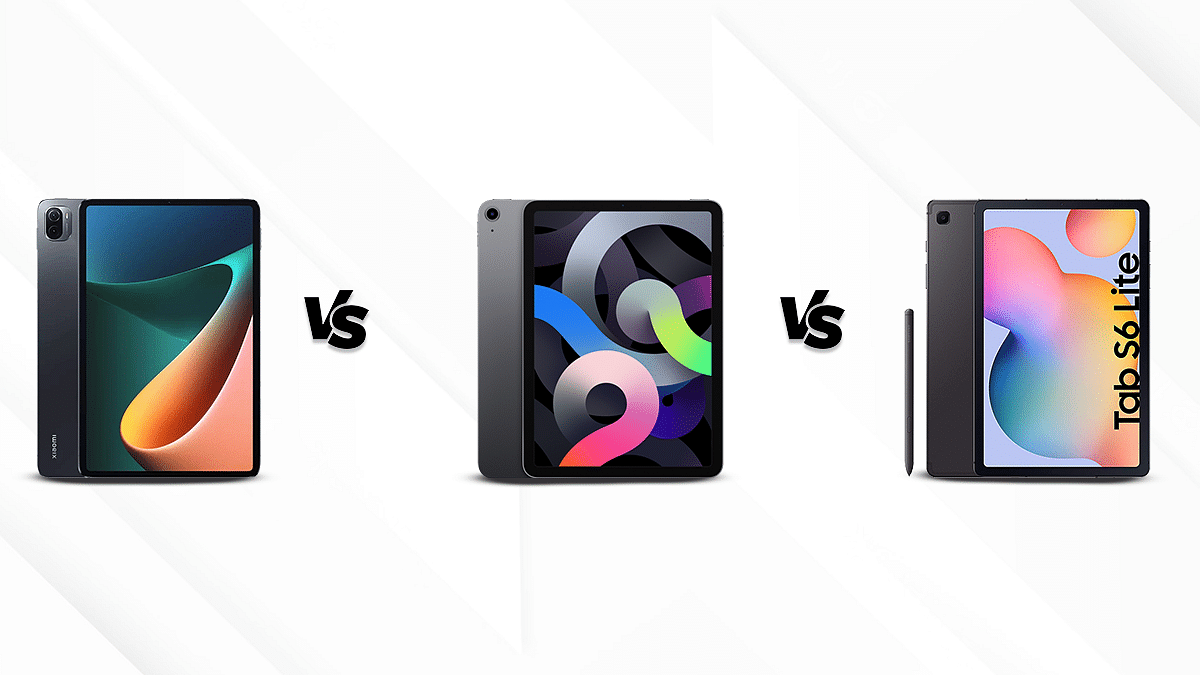Key Highlights
- The following is the comprehensive comparison between three latest best-selling tablets in India.
- The Xiaomi Pad 5 offers close competition to the iPad Air and emerged as having a better display.
The recent decade has witnessed a soaring high demand for tablets. The large screen gadgets have become popular amongst students and work professionals for and versatility in functions. Apple has secured its position in the market for producing high-end flagship gadgets and has faced competition from several Chinese tech giants including Xiaomi which aims at manufacturing cost-effective devices. Samsung is also popular for its durable gadgets. Today we are comparing three of the best-selling tablets including the Xiaomi Pad 5, the Apple iPad Air, and the Galaxy Tab S6 Lite. Read on to know more-
| Specification | Xiaomi Pad 5 | Apple iPad Air | Galaxy Tab S6 Lite |
| Display Size | 11-inch | 10.9-inch | 10.4-inch |
| Resolution | 1600 x 2560 pixels | 1640 x 2360 pixels | 1200 x 2000 pixels |
| Camera | 13MP(back); 8MP(front) | 12MP(back); 12MP(front) | 8MP(back); 5MP(front) |
| Processor | Snapdragon 860 processor | Apple M1 chipset | Snapdragon 720G chipset |
| Storage Capacity | Upto 6GB RAM and 256GB | Upto 8GB RAM and 256GB | Upto 4GB RAM and 128GB |
| Battery | 8720 mAh | 7606 mAh | 7040 mAh |
Display Specifications
The Xiaomi Pad 5 features an 11-inches screen which has a resolution of 1600 x 2560 pixels. This tablet’s display ensures vivid color production and high brightness levels. It has a refresh rate of 120Hz and a pixel density of 274 PPI which allows for a good viewing experience in general scenarios.
The iPad Air has a liquid retina display which prevents eye fatigue. Moreover, it has a massive screen of 10.9 inches and a pixel density of 264 PPI. Apple tablets are popular for their impressive display output and rich visual experience. Similarly, the iPad Air has a resolution of 1640 x 2360 pixels and comes with a special scratch-resistant glass, which makes it shine as new.
The Samsung Galaxy Tab S6 Lite is equipped with a 10.4 inches screen with a pixel density of 224 PPI and a resolution of 1200 x 2000 pixels.
Overall, the Xiaomi Pad 5 offers close competition to the iPad Air and emerged as having a better display. However, the Galaxy Tab S6 Lite isn’t far behind and offers a decent video playback experience.
Chipset Comparison
The Xiaomi Pad 5 operates on the Qualcomm Snapdragon 860 processor based on a 7nm fabrication process. It is an octa-core CPU with up to 6GB RAM and 256GB storage. It does not feature expandable memory.
The Apple iPad Air houses an Apple M1 chipset. It is also available in two variants, which have 8GB RAM and 64GB and 256GB of ROM respectively.
The Samsung Galaxy Tab S6 Lite is equipped with Snapdragon 720G chipset, which is also an octa-core chipset for premium mid-range smartphones and tablets. It is also available in two variants, both of which have 4GB RAM along with 64GB and 128GB of ROM respectively. However, it has an upper edge over the rest of the two in terms of expandable memory. It has a dedicated microSD card slot.
Overall, the Apple iPad Air offers impressive performance and has higher RAM.
Camera Features
The Xiaomi Pad 5 has a 13MP (f\2.0) rear camera which comes with the features such as HDR, panorama mode, 4K, and 1080P video recording. Apart from that, it also comes with an 8MP (f\2.0) front camera for selfies and video calling
On the other hand, the Apple iPad Air has a 12MP (f\1.8) rear camera which supports HDR, PDAF, and 1080P, 4K video recording. It offers electronic image stabilization as well. It also has a 12MP (f\2.4) ultra-wide camera front camera.
The Samsung Galaxy Tab S6 Lite has an 8MP wide rear camera that supports HDR, panorama mode, and video recording of 1080P@ 30fps. The 5MP ultrawide front camera also captures decent shots.
The Apple iPad Air has ruled out the others in the camera department. Even though the Xiaomi Pad 5 offers close competition to it.
Battery and Fast Charging
The Xiaomi Pad 5 has a massive 8720mAh Li-Po battery. It is accompanied by a 33W fast charging technology. It can be fuelled up to full within just two hours and can support up to 16 hours of video playback.
The Apple iPad Air features a 28.6Wh battery, which gets charged via the 30W charger. It takes about two hours to completely charge it and it can support up to 10 hours of playback.
The Samsung Galaxy Tab S6 Lite houses a 7040mAh battery which can be charged by the 15W charger. It takes about three hours and can support up to 13 hours of video playback.
Overall, the Xiaomi Pad 5 has emerged as the best performer in the battery life department. Moreover, it supports fast chagrin as well.
Final Verdict: Which One Should You Choose?
The Apple iPad Air emerges as an effective choice over the other two. It has a higher megapixel camera, a richer display, and smooth performance. However, the Xiaomi Pad 5 has succeeded in the battery life and charging department. Overall, the Xiaomi Pad 5 offers stiff competition to the Apple iPad Air and has fairly similar features. The Xiaomi Pad 5 can be chosen as its effective alternative.

